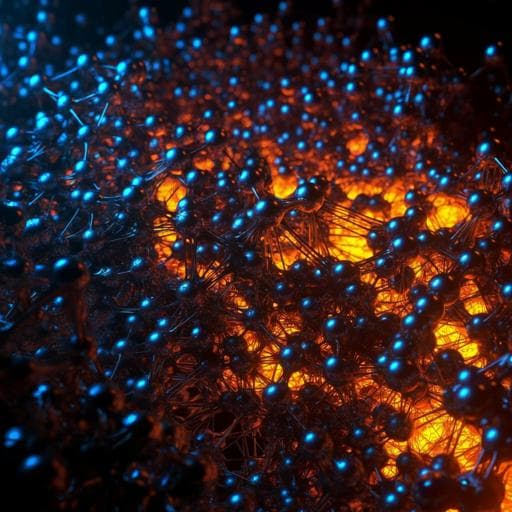
Engineering and Technology
Predicting temperature-dependent ultimate strengths of body-centered-cubic (BCC) high-entropy alloys
B. Steingrimsson, X. Fan, et al.
This groundbreaking research, conducted by B. Steingrimsson, X. Fan, X. Yang, M. C. Gao, Y. Zhang, and P. K. Liaw, unveils a novel bilinear log model that predicts the temperature-dependent ultimate strength of high-entropy alloys, focusing on the critical break temperature essential for high-temperature materials design.
~3 min • Beginner • English
Introduction
The study addresses how to predict and optimize the ultimate strength (US) of high-entropy alloys (HEAs), especially across temperatures, using limited experimental data while incorporating physics-based dependencies. The context is the growing interest in HEAs for structural applications requiring high strength under varied operating conditions. The authors aim to (1) develop a framework for joint optimization of mechanical properties, (2) introduce and validate a predictive bilinear log model for temperature-dependent US that includes a break temperature T_break, and (3) identify and experimentally verify HEA compositions with high US. The importance stems from the need to design alloys that maintain strength at elevated temperatures and to use methods that remain robust under data scarcity by leveraging physical insights alongside data-driven optimization.
Literature Review
Prior work has explored HEAs and their mechanical properties, including foundational reviews and texts on HEAs (e.g., Miracle & Senkov 2017; Gao et al. 2016; Zhang et al. 2014), and on refractory HEAs (Senkov et al. 2010). Data analytics and machine learning have been applied to materials design, with evidence that simple linear models can approach the performance of complex ML (Agrawal et al. 2014 reported R² ≈ 0.963 for linear vs 0.972 for ANN on steel fatigue strength). For temperature-dependent strength, earlier models typically used a single exponential for yield strength (Wu et al. 2014; Maresca & Curtin 2020), lacking a break temperature concept. Senkov et al. (2019) provided physical rationale for two regimes governed by diffusion: below ~0.4 T_m transformations are kinetically restricted, while above ~0.5–0.6 T_m diffusion-controlled mechanisms dominate, motivating bilinear behavior in log strength vs T/T_m. Solid-solution strengthening models (Rao et al. 2019) perform best at lower temperatures where diffusion effects are negligible. In FCC superalloys, anomalous yield phenomena can introduce non-monotonic (hump) behavior requiring more than two regimes for accurate modeling, but such effects are unlikely in BCC/hexagonal refractory HEAs.
Methodology
Data and features: The authors curated a dataset (primarily compression US) from prior work, focusing initially on room temperature for consistency. Two composition feature vectors were defined: A = [%Al, %Mo, %Nb, %Ti, %V, %Ta, %Zr, %Hf] with 19 instances; and B = A plus %Cr with 22 instances. Quality checks included uncertainty reporting and proportionality checks with yield strength (YS). Modeling at room temperature: Multi-variate linear regression was used to predict US as a function of composition: minimize ||X b − y||₂ with closed-form solution b = (XᵀX)⁻¹ Xᵀ y; for small or ill-conditioned datasets, the pseudoinverse (XᵀX)⁺ is recommended. The model choice follows Occam’s razor given limited data and supports extrapolation along the gradient from the best-performing composition by small steps. Temperature-dependent modeling: The US across temperature is modeled as a bilinear log model parameterized by T_m, with two exponential regimes and a break temperature T_break ensuring continuity: US₁(T) = exp(−C₁ T/T_m + C₂) for low T, US₂(T) = exp(−C₃ T/T_m + C₄) for high T, with US(T) = min(US₁, US₂) in log domain, and T_break = (C₄ − C₂) T_m / (C₃ − C₁). A physics constraint is imposed: 0.35 ≤ T_break/T_m ≤ 0.55. Coefficients can be estimated by linear regression within designated T/T_m ranges or, preferably, by global optimization that concurrently fits both regimes by minimizing the squared error norm in either linear or logarithmic domains. Matlab’s fminunc was used for unconstrained minimization, alloy-by-alloy. Model extension: Where non-convexities or humps exist (e.g., certain superalloys), piecewise linear regression and higher-order models (trilinear or more exponentials) are used, explicitly optimizing break temperatures as parameters. For new alloy systems, T_m can be estimated by rule of mixtures and refined via CALPHAD. Joint optimization framework: The US prediction is embedded in a broader framework modeling US = h(composition, T, process, defects, grain size, microstructure), enabling sequential learning and multi-property optimization under physics-based dependencies. Experimental validation: Selected predicted compositions and references were cast by arc melting and tested in compression (default strain rate 1×10⁻³ s⁻¹). Microstructure and phase analyses used SEM/EDX and XRD.
Key Findings
- The bilinear log model markedly outperforms a single-exponential model for temperature-dependent US of 21 BCC/refractory HEAs.
- Quantitatively, averaging over compositions No. 1–10 and 17–21 (Table 2): MSE in log domain is 0.003 (two exponentials) vs 0.195 (single exponential); in linear domain, 528 vs 122,587.
- Break temperature T_break and high-temperature slope C₃ quantify high-temperature strength retention:
- Highest T_break: MoNbTaW at 1124.8 °C; MoNbTaVW at 970.2 °C.
- Smallest high-temperature slope C₃: MoNbTaVW at 4.85 (excluding a curated 1600 °C data point); including that point gives MoNbTaW the lowest C₃ = 2.75. Several Al–Cr–Nb–Ti–V variants show steep slopes (~18–20), indicating faster strength loss.
- Experimental verification at room temperature confirms higher strengths for predicted compositions versus references (Table 1):
- Al0.5Mo0.5Nb1.5Ta0.5Zr1.5: σy = 1791 MPa, σmax = 2024 MPa, εf = 7.6% vs reference Al0.5Mo0.5Nb1Ta0.5Zr1.5: σy = 1786 MPa, σmax = 1910 MPa, εf = 7.6%.
- Mo1.25Nb1.25Ti0.5V0.5Zr1.25: σy = 1705 MPa, σmax = 2013 MPa, εf = 10.0%.
- MoNbTiV0.75Zr (3 mm): σy = 1675 MPa, σmax = 2427 MPa, εf = 25.1%; (5 mm, 2×10⁻⁴ s⁻¹): σy = 1599 ± 40 MPa, σmax = 1780 ± 70 MPa, εf = 8.6 ± 2.8%.
- Microstructural characterization of predicted alloys reveals two BCC phases and dendrite/inter-dendrite segregation, consistent with solid-solution and second-phase strengthening contributions.
- Physics-based justification supports two regimes: diffusion-limited behavior below ~0.4 T_m and diffusion-controlled softening above ~0.5–0.6 T_m, aligning with observed bilinear log behavior.
Discussion
The bilinear log model incorporating T_break captures essential physics of strength retention in refractory BCC HEAs, providing a robust predictor under limited data by constraining model form with diffusion-governed regimes. The approach allows consistent interpretation across experimental data, empirical thermodynamics rules, and model predictions. High T_break and small high-temperature slope C₃ identify alloys better suited for elevated-temperature applications; e.g., MoNbTaW’s high T_break validates the model’s linkage to constituent refractory melting points, while differences in slope underscore the role of dislocation mechanisms and atomic mismatch beyond melting point considerations. The room-temperature linear-regression-based screening successfully guided composition optimization, and experimental compression tests confirmed predicted strength improvements, addressing the research objective of predicting and validating higher-US HEAs. Embedding the temperature model within a joint optimization framework enables future multi-property design and sequential learning strategies tailored to data availability.
Conclusion
A bilinear log model with a physically meaningful break temperature, T_break, accurately predicts temperature-dependent ultimate strength in BCC/refractory HEAs and outperforms single-exponential models. T_break emerges as a critical design parameter for high-temperature applications and should be included in alloy specifications to ensure operating temperatures remain below strength-loss thresholds. With limited yet curated data, simple multi-variate linear regression effectively guided room-temperature composition optimization, and subsequent experiments validated the predicted strength improvements. The study establishes a general, physics-informed framework for joint optimization of alloy properties, recommending method selection matched to data volume and physics. Future work should extend the framework to include ductility and other properties, expand datasets for improved generalization, and pursue sequential learning to accelerate discovery.
Limitations
- Data scarcity: Many compositions have limited temperature data; several entries in Table 2 explicitly require more data, and some parameter estimates (e.g., slopes) are based on as few as three points.
- Measurement modality: The dataset is predominantly compression-based, with very few tensile US measurements, which may limit transferability to tensile behavior.
- Model scope: While bilinear behavior is well-justified for BCC refractory HEAs, alloys exhibiting anomalous yield (e.g., certain FCC superalloys) may require tri- or higher-order models; piecewise fitting introduces potential non-convexity and model selection complexity.
- Parameter estimation: T_m for new systems may rely on rule-of-mixtures or CALPHAD estimates, introducing uncertainty; data curation decisions (e.g., omitting suspect points) can affect fitted slopes and T_break.
- Generalizability: The room-temperature regression uses modest sample sizes (19–22 for feature sets A/B), which constrains extrapolation and emphasizes the need for sequential data augmentation and validation.
Related Publications
Explore these studies to deepen your understanding of the subject.







